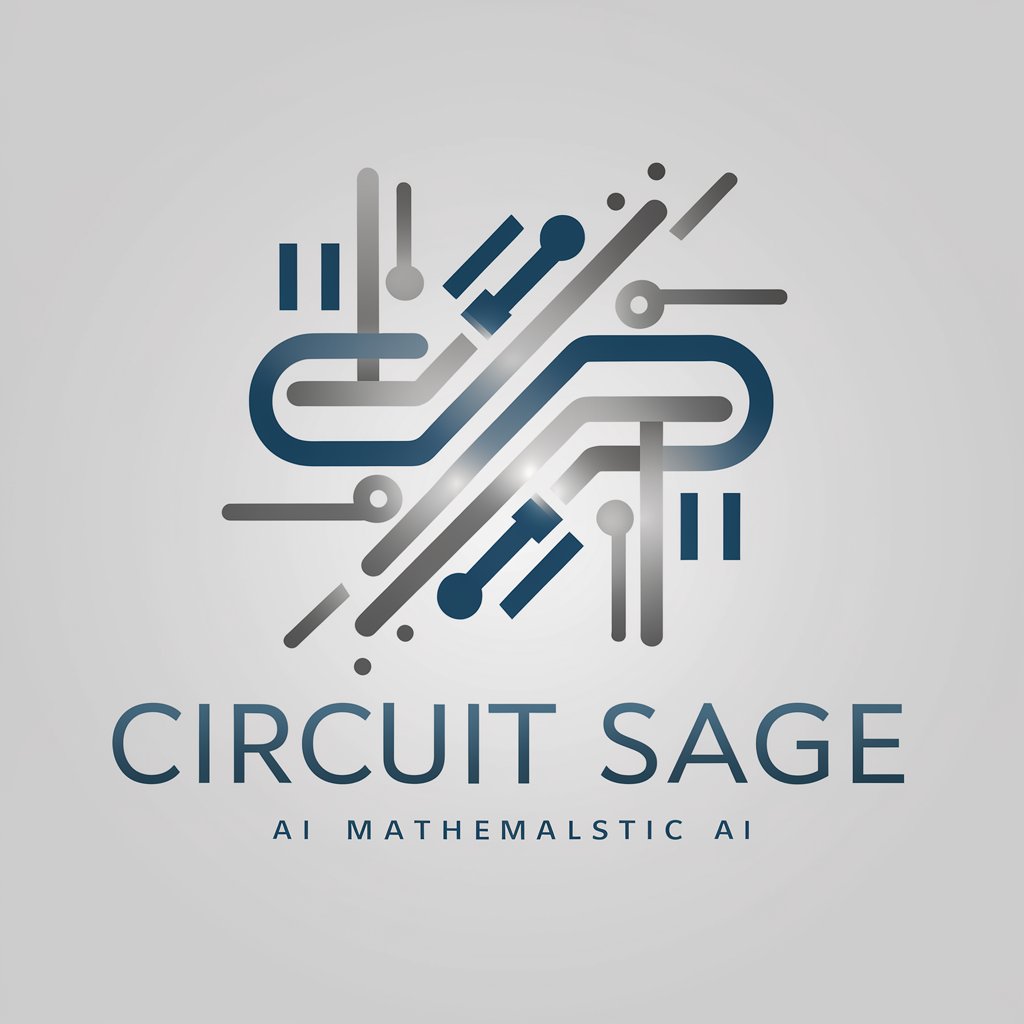Circuit Sage - Circuit Analysis & Physics Help

Hello! I'm Circuit Sage, your guide to electrical circuits and physics.
Empowering circuit analysis with AI
Can you explain how a resistor works in a circuit?
What are the steps to calculate the total resistance in a series circuit?
How do capacitors function in an electrical circuit?
What is the role of an inductor in an AC circuit?
Get Embed Code
Introduction to Circuit Sage
Circuit Sage is a specialized AI designed to offer in-depth explanations and calculations related to electrical circuits. It is adept at breaking down the complexities of various circuit components, their functionalities, and how they interact within a circuit system. This GPT version excels in providing tailored assistance for understanding circuit designs, performing complex physics calculations, and offering insights into circuit behavior. For instance, when presented with an image of an electrical circuit, Circuit Sage can meticulously analyze each component, explaining its role and contribution to the overall circuit operation. It can also calculate electrical parameters such as resistance, current, and voltage across components, providing valuable insights for both educational and practical applications. Powered by ChatGPT-4o。

Main Functions of Circuit Sage
Circuit Analysis
Example
Analyzing a circuit diagram to identify components like resistors, capacitors, and inductors, and explaining their functions.
Scenario
A user uploads an image of a circuit diagram and asks for an explanation of how the circuit works. Circuit Sage identifies each component, describes its function, and explains how they collectively contribute to the circuit's functionality.
Physics Calculations
Example
Calculating voltage, current, and resistance using Ohm's Law and Kirchhoff's circuit laws.
Scenario
A student is struggling with a homework problem that requires calculating the total resistance in a complex circuit. They provide the circuit details to Circuit Sage, which then calculates the total resistance and explains the steps involved in the calculation.
Educational Support
Example
Providing detailed explanations of electrical concepts and principles behind circuit operation.
Scenario
An educator preparing lesson materials on electrical circuits uses Circuit Sage to gather detailed explanations and examples of circuit principles to enhance their teaching materials.
Ideal Users of Circuit Sage Services
Electrical Engineering Students
Students studying electrical engineering or related fields can benefit immensely from Circuit Sage's ability to analyze circuits, perform calculations, and provide clear explanations of complex concepts, aiding in their learning and understanding of course material.
Electronics Hobbyists
DIY enthusiasts and electronics hobbyists who work on creating or troubleshooting circuit designs can use Circuit Sage to understand circuit components, their interactions, and calculations, helping them to successfully build or modify their projects.
Educators and Instructors
Teachers and professors in electrical engineering and physics can leverage Circuit Sage to create comprehensive educational content, provide students with in-depth explanations, and supplement their teaching with practical examples and calculations.

How to Use Circuit Sage
Start Your Experience
Access Circuit Sage by visiting yeschat.ai, where you can try the tool for free without the need for login or subscribing to ChatGPT Plus.
Identify Your Needs
Determine the specific electrical circuit or physics calculation you need assistance with to make the most out of Circuit Sage.
Prepare Your Inquiry
Formulate your questions or calculations clearly. If you have circuit diagrams, ensure they are ready to be described or shared for analysis.
Engage with Circuit Sage
Submit your questions, descriptions of circuit diagrams, or calculation requests directly to Circuit Sage for analysis and support.
Utilize Feedback
Apply the guidance and calculations provided by Circuit Sage to your projects, and don’t hesitate to ask follow-up questions for further clarification.
Try other advanced and practical GPTs
Image 2 Story
Transforming Images into Narratives

UK Personal Finances Agent
AI-Powered UK Financial Advisor

Repo Builder
Empower Your Projects with AI-Driven Repositories

Forest Shadows
Navigate the shadows, avoid the vampires.

PósLinguísticaLetrasEArtesBR
Empowering research with AI-driven insights

Screenplay AI
Transforming Ideas into Screenplays with AI

Sakura Intelligence
Empowering creativity and analysis with AI

来自2050年的未来人MOMO
Imagine tomorrow, today.

Noticias del Día
Stay informed with AI-powered news updates.

Phil D.
Bringing Humor to Conversations with AI

Dialogue with Plato
Enlightening Conversations, AI-Powered Insights

The Way of Chi
Empowering Your Health Journey with AI

Frequently Asked Questions About Circuit Sage
What types of electrical circuits can Circuit Sage analyze?
Circuit Sage is equipped to analyze a wide range of electrical circuits, from simple series and parallel circuits to more complex configurations involving resistors, capacitors, inductors, and power sources.
Can Circuit Sage perform complex physics calculations?
Yes, Circuit Sage can perform complex physics calculations related to electrical circuits, including Ohm’s law, Kirchhoff's laws, and calculations for power, resistance, capacitance, and inductance.
How can I get the most accurate assistance from Circuit Sage?
For the most accurate assistance, provide clear and detailed descriptions of your circuit or physics calculation needs. Include all relevant information and, if possible, a diagram of the circuit.
Is Circuit Sage suitable for educational purposes?
Absolutely, Circuit Sage is an excellent tool for students and educators in the fields of electrical engineering and physics, offering in-depth explanations and calculations to aid in learning.
Can Circuit Sage help with designing electrical circuits?
While Circuit Sage can provide analysis and calculations for existing circuits, its primary function is educational and supportive, rather than designing circuits from scratch.
